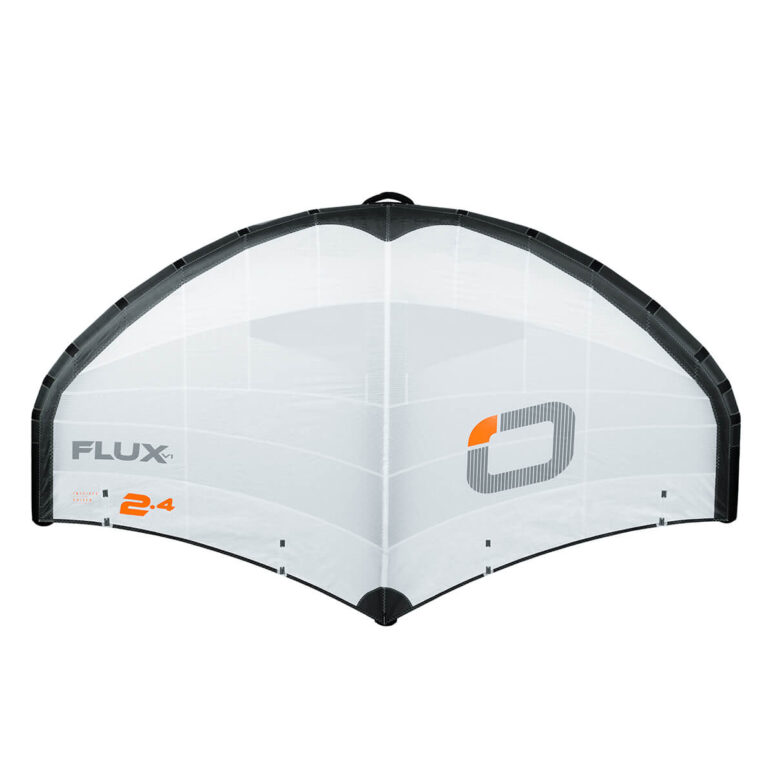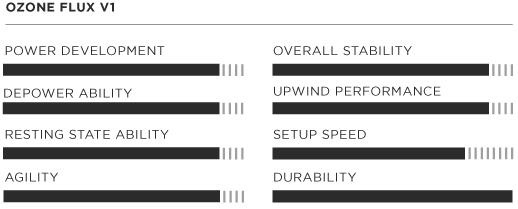

When you purchase gear through links on our site, we may earn a small commission. Here’s why you can trust our tests and our affiliate partner.

Ozone’s recently released entry level oriented Fly wing was designed with a new module of their in-house OzCAD design software, which has produced many a legendary kite. This software has now been utilized to produce the Flux, which has a considerably different design remit, with speed and performance at the forefront of the agenda. Ozone are one of the only brands that own their own factory rather than using OEM. Proudly manufacturing in Vietnam, with the best QC in the business, not a stitch sits out of place on the Flux. It’s a masterclass in sewing and accuracy, and you can see different seaming has been implemented on the leading edge to accommodate the new tube material with impressive attention to detail over the canopy construction.
Material use is a hot topic for wing design in 2023, and Ozone have pulled out all the stops with the Flux. An all-new and super shiny 125g Dacron has been implemented, providing an exceptionally stiff and lightweight airframe which inflates via two separate and familiar red Boston valves. The leading edge has a large amount of segmentation, making a great job of smoothing the wing from an aerodynamic perspective. We’re looking at a lean and fairly high-aspect shape with quite a dramatic leading edge sweep and light dihedral. If anything can look fast when stationary, this is a prime example.
The canopy comprises of an intricate paneling layout to distribute load evenly out to the wingtips along the seams running across its span. It’s built in three distinct sections. Along the front side of the LE and rear quarter along the trailing edge, another new material has been implemented in the form of a harder wearing 95g ripstop, which feels ultra crisp to the touch. This hints at longevity in the design of this high-wear area and should prevent long-term bagging. The center section is made from a more standard three core Teijin cloth found across their current kite range. Two smaller front facing windows are made from a lightweight and flexible material which has hydrophobic properties and remains clear when wet. On inflation, it’s clear that some preload has been designed into the canopy to form a super clean aerofoil with very little creasing. The trailing edge harbors six removable mini battens in pockets to control any potential vibration here.
The wing’s profile, we’d describe as mid depth, with a floating batten attached to the canopy with a profiled piece of ripstop at the front and direct connection to the strut at the rear. The strut is completely straight and a fairly narrow diameter, and accommodates two rigid EVA covered handles with lightweight carbon fiber cores, which have a slim diameter and round grip, angling themselves towards the rider in a welcoming and ergonomic fashion. The front handle has an intelligently placed rubbery coating to avoid damaging your board. The nose handle has a little flex and a comfortable backing panel to avoid knuckle chaff.
Whilst the airframe and rigid handle system, combined with the pre-loaded canopy design, all hint at a wing that could be a bit of a handful, there’s enough reflex in those tapered wingtips to smooth out the bumps and keep things comfortable. The forward drive of the wing also reduced fatigue; where wings with more downwind tendency will give you grief through the gusts, the Flux seems to transfer this energy into forward momentum and speed. This reflex in the wing makes for an easy-to-access pumping cadence procedure to get on foil, and the upper wind range once lit up is far extended over their previous WASP range. Once up on foil, the wing feels immediately rapid and dynamic, absolutely hammering upwind. The handles feel well connected and allow excellent control when performing more technical transitions, Heineken jibes were very easy as you’d expect. The slimmer profile and inbuilt canopy tension allows it to transition upwind through a tack with minimal disturbance and drag, keeping you well composed on foil. Access to lift for jumping is easy to time, and the wing holds its shape well in the air to give you a decent chance of landing. It powers out of turns well, and suits a generally fast riding pace and foil system.
The Flux is perhaps the wing Ozone fans have been waiting for. Searingly rapid forward speed with lightweight handling, intelligent material use, and what’s potentially the best build on the market is a heady combination of factors. A wide usable range per size and high level of composure through that massive wind range enable the rider a technical advantage, and you can see why the marketing from Ozone is perhaps a little race-driven. What’s not to be underestimated is how well all these attributes apply as a freeride and wave wing – the light weight and excellent balance when flagged make for a very competitive wave performance. Its upwind ability is startling, and once on foil you can run exceptionally efficiently on apparent wind alone, particularly noticeable in lighter wind conditions. It’s a premium wing in every sense of the word, which looks and feels like it’s been built to a specification rather than a price point. The Flux sits proudly on the starting grid like a thoroughbred racehorse chomping at the bit. It’s securely amongst the top brass of contemporary wings, and is futuristic in both performance and appearance.
